overheating JEEP COMPASS 2020 Owner handbook (in English)
[x] Cancel search | Manufacturer: JEEP, Model Year: 2020, Model line: COMPASS, Model: JEEP COMPASS 2020Pages: 328, PDF Size: 8.85 MB
Page 135 of 328
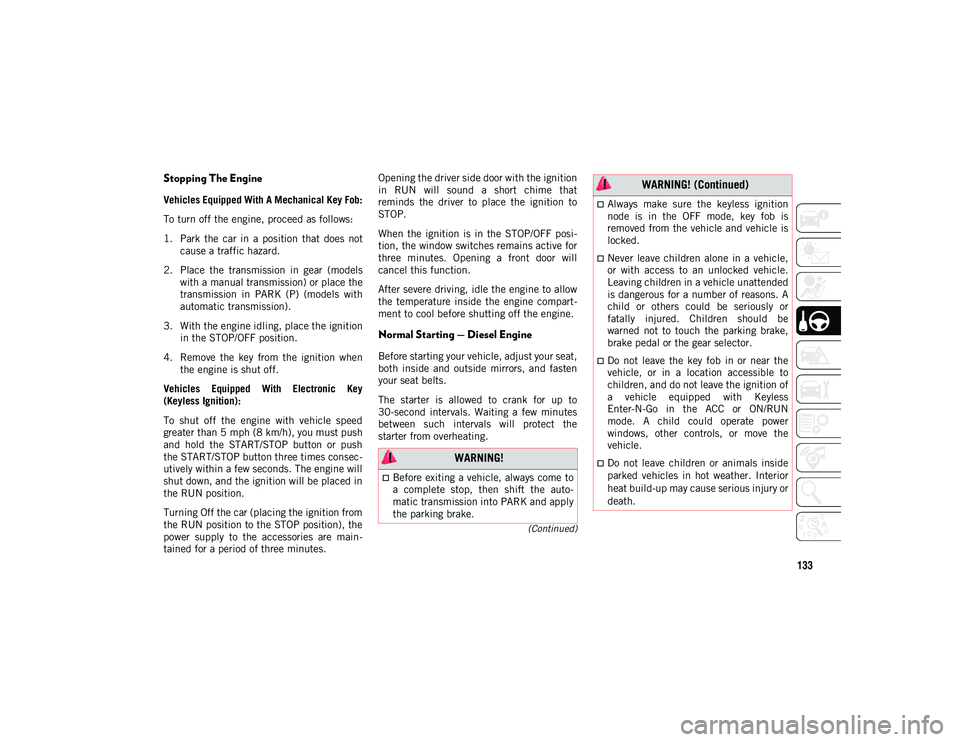
133
(Continued)
Stopping The Engine
Vehicles Equipped With A Mechanical Key Fob:
To turn off the engine, proceed as follows:
1. Park the car in a position that does notcause a traffic hazard.
2. Place the transmission in gear (models with a manual transmission) or place the
transmission in PARK (P) (models with
automatic transmission).
3. With the engine idling, place the ignition in the STOP/OFF position.
4. Remove the key from the ignition when the engine is shut off.
Vehicles Equipped With Electronic Key
(Keyless Ignition):
To shut off the engine with vehicle speed
greater than 5 mph (8 km/h), you must push
and hold the START/STOP button or push
the START/STOP button three times consec -
utively within a few seconds. The engine will
shut down, and the ignition will be placed in
the RUN position.
Turning Off the car (placing the ignition from
the RUN position to the STOP position), the
power supply to the accessories are main -
tained for a period of three minutes. Opening the driver side door with the ignition
in RUN will sound a short chime that
reminds the driver to place the ignition to
STOP.
When the ignition is in the STOP/OFF posi
-
tion, the window switches remains active for
three minutes. Opening a front door will
cancel this function.
After severe driving, idle the engine to allow
the temperature inside the engine compart -
ment to cool before shutting off the engine.
Normal Starting — Diesel Engine
Before starting your vehicle, adjust your seat,
both inside and outside mirrors, and fasten
your seat belts.
The starter is allowed to crank for up to
30-second intervals. Waiting a few minutes
between such intervals will protect the
starter from overheating.
WARNING!
Before exiting a vehicle, always come to
a complete stop, then shift the auto-
matic transmission into PARK and apply
the parking brake.
Always make sure the keyless ignition
node is in the OFF mode, key fob is
removed from the vehicle and vehicle is
locked.
Never leave children alone in a vehicle,
or with access to an unlocked vehicle.
Leaving children in a vehicle unattended
is dangerous for a number of reasons. A
child or others could be seriously or
fatally injured. Children should be
warned not to touch the parking brake,
brake pedal or the gear selector.
Do not leave the key fob in or near the
vehicle, or in a location accessible to
children, and do not leave the ignition of
a vehicle equipped with Keyless
Enter-N-Go in the ACC or ON/RUN
mode. A child could operate power
windows, other controls, or move the
vehicle.
Do not leave children or animals inside
parked vehicles in hot weather. Interior
heat build-up may cause serious injury or
death.
WARNING! (Continued)
2020_JEEP_M6_UG_UK.book Page 133
Page 146 of 328
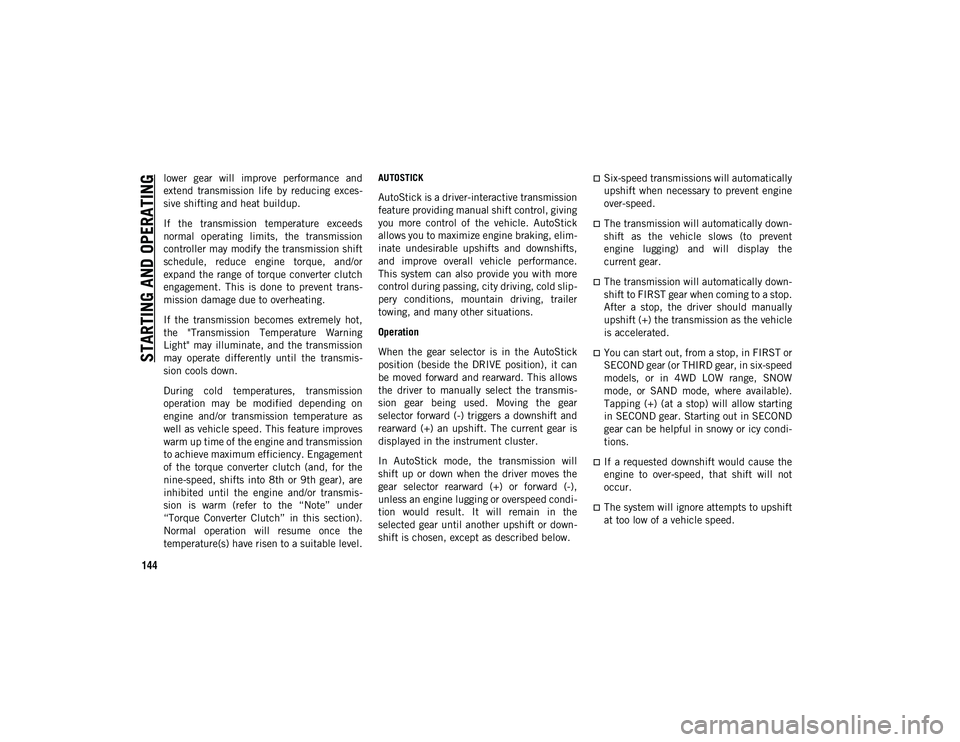
STARTING AND OPERATING
144
lower gear will improve performance and
extend transmission life by reducing exces-
sive shifting and heat buildup.
If the transmission temperature exceeds
normal operating limits, the transmission
controller may modify the transmission shift
schedule, reduce engine torque, and/or
expand the range of torque converter clutch
engagement. This is done to prevent trans -
mission damage due to overheating.
If the transmission becomes extremely hot,
the "Transmission Temperature Warning
Light" may illuminate, and the transmission
may operate differently until the transmis -
sion cools down.
During cold temperatures, transmission
operation may be modified depending on
engine and/or transmission temperature as
well as vehicle speed. This feature improves
warm up time of the engine and transmission
to achieve maximum efficiency. Engagement
of the torque converter clutch (and, for the
nine-speed, shifts into 8th or 9th gear), are
inhibited until the engine and/or transmis -
sion is warm (refer to the “Note” under
“Torque Converter Clutch” in this section).
Normal operation will resume once the
temperature(s) have risen to a suitable level.AUTOSTICK
AutoStick is a driver-interactive transmission
feature providing manual shift control, giving
you more control of the vehicle. AutoStick
allows you to maximize engine braking, elim -
inate undesirable upshifts and downshifts,
and improve overall vehicle performance.
This system can also provide you with more
control during passing, city driving, cold slip -
pery conditions, mountain driving, trailer
towing, and many other situations.
Operation
When the gear selector is in the AutoStick
position (beside the DRIVE position), it can
be moved forward and rearward. This allows
the driver to manually select the transmis -
sion gear being used. Moving the gear
selector forward (-) triggers a downshift and
rearward (+) an upshift. The current gear is
displayed in the instrument cluster.
In AutoStick mode, the transmission will
shift up or down when the driver moves the
gear selector rearward (+) or forward (-),
unless an engine lugging or overspeed condi -
tion would result. It will remain in the
selected gear until another upshift or down -
shift is chosen, except as described below.
Six-speed transmissions will automatically
upshift when necessary to prevent engine
over-speed.
The transmission will automatically down -
shift as the vehicle slows (to prevent
engine lugging) and will display the
current gear.
The transmission will automatically down -
shift to FIRST gear when coming to a stop.
After a stop, the driver should manually
upshift (+) the transmission as the vehicle
is accelerated.
You can start out, from a stop, in FIRST or
SECOND gear (or THIRD gear, in six-speed
models, or in 4WD LOW range, SNOW
mode, or SAND mode, where available).
Tapping (+) (at a stop) will allow starting
in SECOND gear. Starting out in SECOND
gear can be helpful in snowy or icy condi -
tions.
If a requested downshift would cause the
engine to over-speed, that shift will not
occur.
The system will ignore attempts to upshift
at too low of a vehicle speed.
2020_JEEP_M6_UG_UK.book Page 144
Page 206 of 328
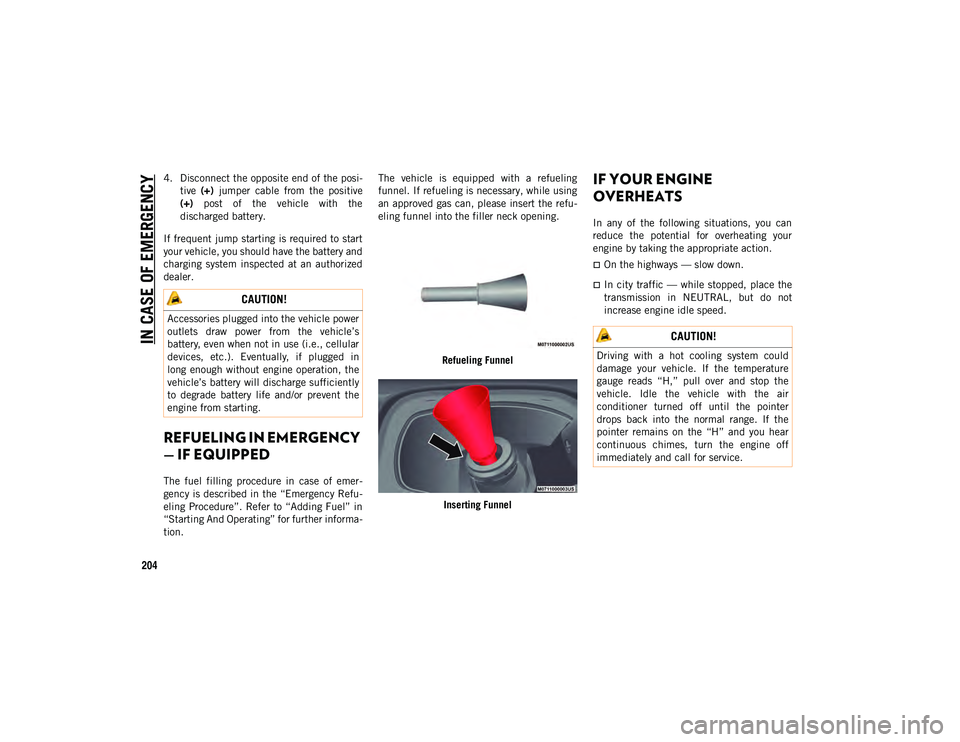
IN CASE OF EMERGENCY
204
4. Disconnect the opposite end of the posi-
tive (+) jumper cable from the positive
(+) post of the vehicle with the
discharged battery.
If frequent jump starting is required to start
your vehicle, you should have the battery and
charging system inspected at an authorized
dealer.
REFUELING IN EMERGENCY
— IF EQUIPPED
The fuel filling procedure in case of emer -
gency is described in the “Emergency Refu -
eling Procedure”. Refer to “Adding Fuel” in
“Starting And Operating” for further informa -
tion. The vehicle is equipped with a refueling
funnel. If refueling is necessary, while using
an approved gas can, please insert the refu
-
eling funnel into the filler neck opening.
Refueling Funnel
Inserting Funnel
IF YOUR ENGINE
OVERHEATS
In any of the following situations, you can
reduce the potential for overheating your
engine by taking the appropriate action.
On the highways — slow down.
In city traffic — while stopped, place the
transmission in NEUTRAL, but do not
increase engine idle speed.
CAUTION!
Accessories plugged into the vehicle power
outlets draw power from the vehicle’s
battery, even when not in use (i.e., cellular
devices, etc.). Eventually, if plugged in
long enough without engine operation, the
vehicle’s battery will discharge sufficiently
to degrade battery life and/or prevent the
engine from starting.
CAUTION!
Driving with a hot cooling system could
damage your vehicle. If the temperature
gauge reads “H,” pull over and stop the
vehicle. Idle the vehicle with the air
conditioner turned off until the pointer
drops back into the normal range. If the
pointer remains on the “H” and you hear
continuous chimes, turn the engine off
immediately and call for service.
2020_JEEP_M6_UG_UK.book Page 204
Page 208 of 328
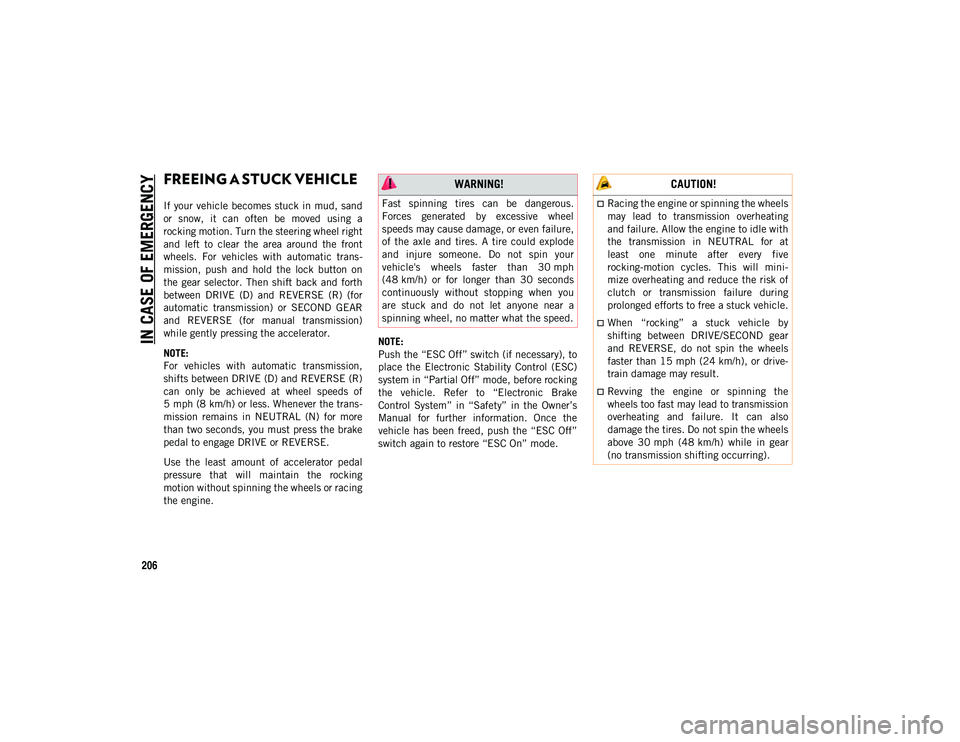
IN CASE OF EMERGENCY
206
FREEING A STUCK VEHICLE
If your vehicle becomes stuck in mud, sand
or snow, it can often be moved using a
rocking motion. Turn the steering wheel right
and left to clear the area around the front
wheels. For vehicles with automatic trans-
mission, push and hold the lock button on
the gear selector. Then shift back and forth
between DRIVE (D) and REVERSE (R) (for
automatic transmission) or SECOND GEAR
and REVERSE (for manual transmission)
while gently pressing the accelerator.
NOTE:
For vehicles with automatic transmission,
shifts between DRIVE (D) and REVERSE (R)
can only be achieved at wheel speeds of
5 mph (8 km/h) or less. Whenever the trans -
mission remains in NEUTRAL (N) for more
than two seconds, you must press the brake
pedal to engage DRIVE or REVERSE.
Use the least amount of accelerator pedal
pressure that will maintain the rocking
motion without spinning the wheels or racing
the engine. NOTE:
Push the “ESC Off” switch (if necessary), to
place the Electronic Stability Control (ESC)
system in “Partial Off” mode, before rocking
the vehicle. Refer to “Electronic Brake
Control System” in “Safety” in the Owner’s
Manual for further information. Once the
vehicle has been freed, push the “ESC Off”
switch again to restore “ESC On” mode.
WARNING!
Fast spinning tires can be dangerous.
Forces generated by excessive wheel
speeds may cause damage, or even failure,
of the axle and tires. A tire could explode
and injure someone. Do not spin your
vehicle's wheels faster than 30 mph
(48 km/h) or for longer than 30 seconds
continuously without stopping when you
are stuck and do not let anyone near a
spinning wheel, no matter what the speed.
CAUTION!
Racing the engine or spinning the wheels
may lead to transmission overheating
and failure. Allow the engine to idle with
the transmission in NEUTRAL for at
least one minute after every five
rocking-motion cycles. This will mini
-
mize overheating and reduce the risk of
clutch or transmission failure during
prolonged efforts to free a stuck vehicle.
When “rocking” a stuck vehicle by
shifting between DRIVE/SECOND gear
and REVERSE, do not spin the wheels
faster than 15 mph (24 km/h), or drive -
train damage may result.
Revving the engine or spinning the
wheels too fast may lead to transmission
overheating and failure. It can also
damage the tires. Do not spin the wheels
above 30 mph (48 km/h) while in gear
(no transmission shifting occurring).
2020_JEEP_M6_UG_UK.book Page 206
Page 231 of 328
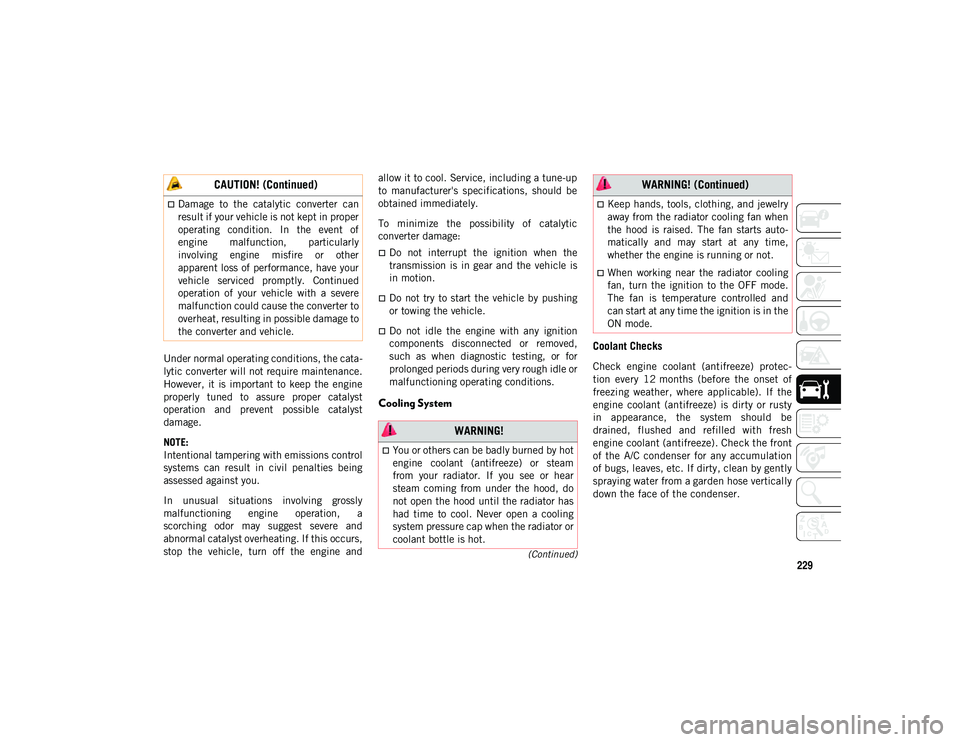
229(Continued)
Under normal operating conditions, the cata-
lytic converter will not require maintenance.
However, it is important to keep the engine
properly tuned to assure proper catalyst
operation and prevent possible catalyst
damage.
NOTE:
Intentional tampering with emissions control
systems can result in civil penalties being
assessed against you.
In unusual situations involving grossly
malfunctioning engine operation, a
scorching odor may suggest severe and
abnormal catalyst overheating. If this occurs,
stop the vehicle, turn off the engine and allow it to cool. Service, including a tune-up
to manufacturer's specifications, should be
obtained immediately.
To minimize the possibility of catalytic
converter damage:
Do not interrupt the ignition when the
transmission is in gear and the vehicle is
in motion.
Do not try to start the vehicle by pushing
or towing the vehicle.
Do not idle the engine with any ignition
components disconnected or removed,
such as when diagnostic testing, or for
prolonged periods during very rough idle or
malfunctioning operating conditions.
Cooling System
Coolant Checks
Check engine coolant (antifreeze) protec
-
tion every 12 months (before the onset of
freezing weather, where applicable). If the
engine coolant (antifreeze) is dirty or rusty
in appearance, the system should be
drained, flushed and refilled with fresh
engine coolant (antifreeze). Check the front
of the A/C condenser for any accumulation
of bugs, leaves, etc. If dirty, clean by gently
spraying water from a garden hose vertically
down the face of the condenser.
Damage to the catalytic converter can
result if your vehicle is not kept in proper
operating condition. In the event of
engine malfunction, particularly
involving engine misfire or other
apparent loss of performance, have your
vehicle serviced promptly. Continued
operation of your vehicle with a severe
malfunction could cause the converter to
overheat, resulting in possible damage to
the converter and vehicle.
CAUTION! (Continued)
WARNING!
You or others can be badly burned by hot
engine coolant (antifreeze) or steam
from your radiator. If you see or hear
steam coming from under the hood, do
not open the hood until the radiator has
had time to cool. Never open a cooling
system pressure cap when the radiator or
coolant bottle is hot.
Keep hands, tools, clothing, and jewelry
away from the radiator cooling fan when
the hood is raised. The fan starts auto-
matically and may start at any time,
whether the engine is running or not.
When working near the radiator cooling
fan, turn the ignition to the OFF mode.
The fan is temperature controlled and
can start at any time the ignition is in the
ON mode.
WARNING! (Continued)
2020_JEEP_M6_UG_UK.book Page 229
Page 234 of 328
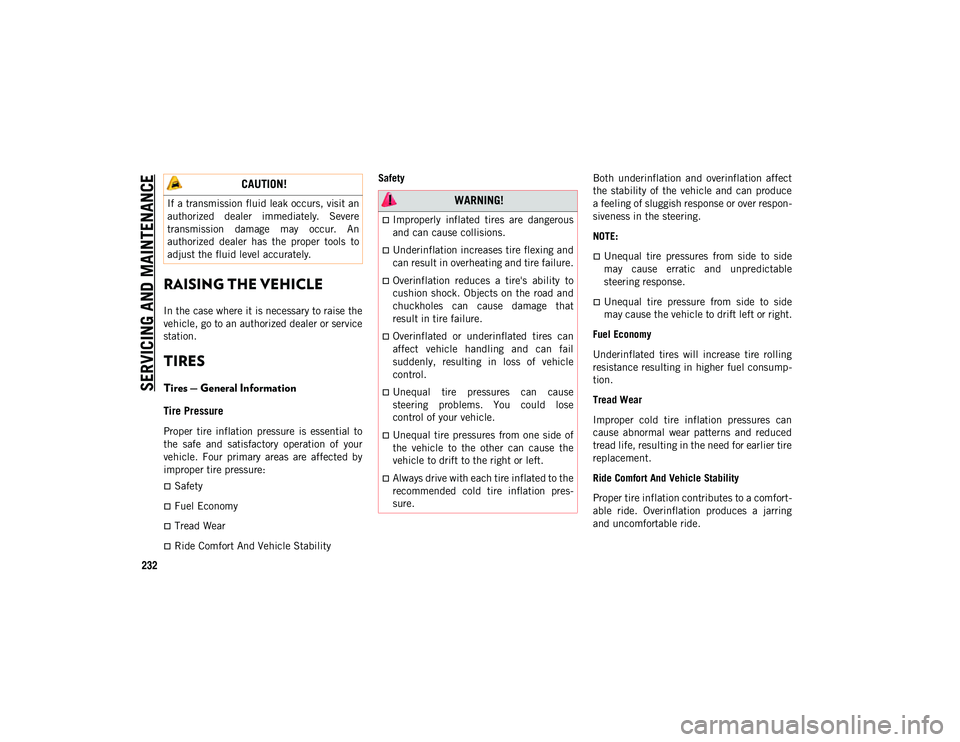
SERVICING AND MAINTENANCE
232
RAISING THE VEHICLE
In the case where it is necessary to raise the
vehicle, go to an authorized dealer or service
station.
TIRES
Tires — General Information
Tire Pressure
Proper tire inflation pressure is essential to
the safe and satisfactory operation of your
vehicle. Four primary areas are affected by
improper tire pressure:
Safety
Fuel Economy
Tread Wear
Ride Comfort And Vehicle StabilitySafety
Both underinflation and overinflation affect
the stability of the vehicle and can produce
a feeling of sluggish response or over respon-
siveness in the steering.
NOTE:
Unequal tire pressures from side to side
may cause erratic and unpredictable
steering response.
Unequal tire pressure from side to side
may cause the vehicle to drift left or right.
Fuel Economy
Underinflated tires will increase tire rolling
resistance resulting in higher fuel consump -
tion.
Tread Wear
Improper cold tire inflation pressures can
cause abnormal wear patterns and reduced
tread life, resulting in the need for earlier tire
replacement.
Ride Comfort And Vehicle Stability
Proper tire inflation contributes to a comfort -
able ride. Overinflation produces a jarring
and uncomfortable ride.
CAUTION!
If a transmission fluid leak occurs, visit an
authorized dealer immediately. Severe
transmission damage may occur. An
authorized dealer has the proper tools to
adjust the fluid level accurately. WARNING!
Improperly inflated tires are dangerous
and can cause collisions.
Underinflation increases tire flexing and
can result in overheating and tire failure.
Overinflation reduces a tire's ability to
cushion shock. Objects on the road and
chuckholes can cause damage that
result in tire failure.
Overinflated or underinflated tires can
affect vehicle handling and can fail
suddenly, resulting in loss of vehicle
control.
Unequal tire pressures can cause
steering problems. You could lose
control of your vehicle.
Unequal tire pressures from one side of
the vehicle to the other can cause the
vehicle to drift to the right or left.
Always drive with each tire inflated to the
recommended cold tire inflation pres-
sure.
2020_JEEP_M6_UG_UK.book Page 232
Page 320 of 328
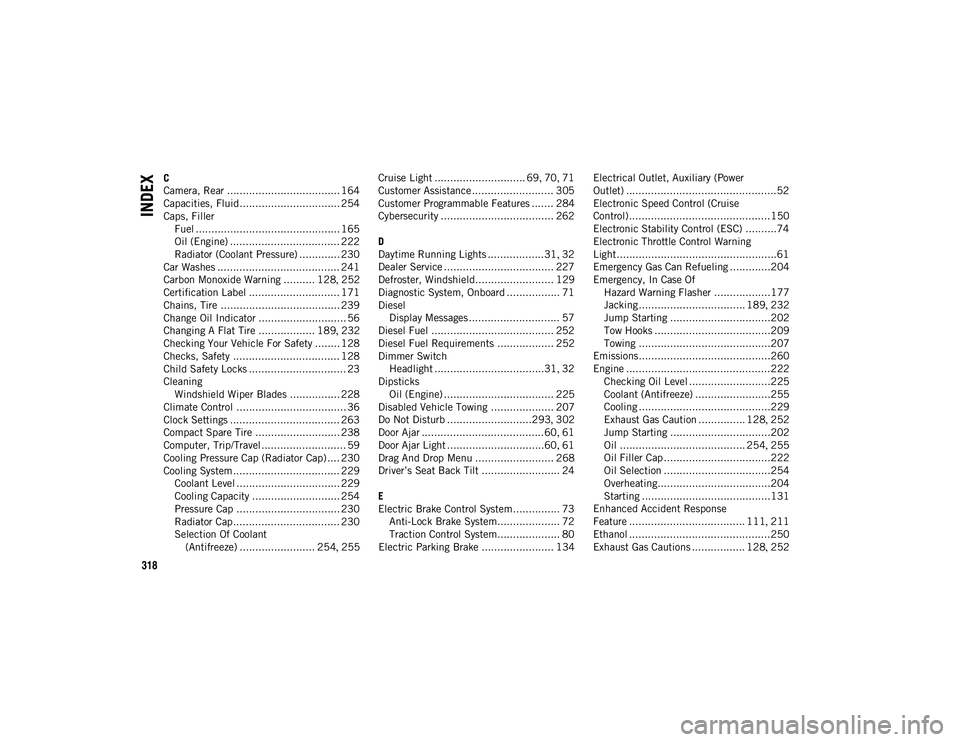
318
INDEX
C
Camera, Rear .................................... 164
Capacities, Fluid................................ 254
Caps, FillerFuel .............................................. 165
Oil (Engine) ................................... 222
Radiator (Coolant Pressure) ............. 230
Car Washes ....................................... 241
Carbon Monoxide Warning .......... 128 , 252
Certification Label ............................. 171
Chains, Tire ...................................... 239
Change Oil Indicator ............................ 56
Changing A Flat Tire .................. 189 , 232
Checking Your Vehicle For Safety ........ 128
Checks, Safety .................................. 128
Child Safety Locks ............................... 23
Cleaning Windshield Wiper Blades ................ 228
Climate Control ................................... 36
Clock Settings ................................... 263
Compact Spare Tire ........................... 238
Computer, Trip/Travel ........................... 59
Cooling Pressure Cap (Radiator Cap) .... 230
Cooling System .................................. 229 Coolant Level ................................. 229
Cooling Capacity ............................ 254Pressure Cap ................................. 230
Radiator Cap.................................. 230
Selection Of Coolant (Antifreeze) ........................ 254 , 255 Cruise Light ............................. 69
, 70 , 71
Customer Assistance .......................... 305
Customer Programmable Features ....... 284
Cybersecurity .................................... 262
D
Daytime Running Lights ..................31 , 32
Dealer Service ................................... 227
Defroster, Windshield......................... 129
Diagnostic System, Onboard ................. 71
Diesel Display Messages ............................. 57
Diesel Fuel ....................................... 252
Diesel Fuel Requirements .................. 252
Dimmer Switch Headlight ...................................31 , 32
Dipsticks Oil (Engine) ................................... 225
Disabled Vehicle Towing .................... 207
Do Not Disturb ...........................293 , 302
Door Ajar .......................................60 , 61
Door Ajar Light ...............................60 , 61
Drag And Drop Menu ......................... 268
Driver’s Seat Back Tilt ......................... 24
E
Electric Brake Control System............... 73 Anti-Lock Brake System.................... 72Traction Control System.................... 80
Electric Parking Brake ....................... 134 Electrical Outlet, Auxiliary (Power
Outlet) ................................................52
Electronic Speed Control (Cruise
Control) .............................................150
Electronic Stability Control (ESC) ..........74
Electronic Throttle Control Warning
Light ...................................................61
Emergency Gas Can Refueling .............204
Emergency, In Case Of Hazard Warning Flasher ..................177
Jacking .................................. 189 , 232
Jump Starting ................................202
Tow Hooks .....................................209
Towing ..........................................207
Emissions..........................................260
Engine ..............................................222 Checking Oil Level ..........................225
Coolant (Antifreeze) ........................255
Cooling ..........................................229Exhaust Gas Caution ............... 128 , 252
Jump Starting ................................202
Oil ........................................ 254 , 255
Oil Filler Cap ..................................222
Oil Selection ..................................254
Overheating....................................204
Starting .........................................131
Enhanced Accident Response
Feature ..................................... 111 , 211
Ethanol .............................................250
Exhaust Gas Cautions ................. 128 , 252
2020_JEEP_M6_UG_UK.book Page 318
Page 323 of 328
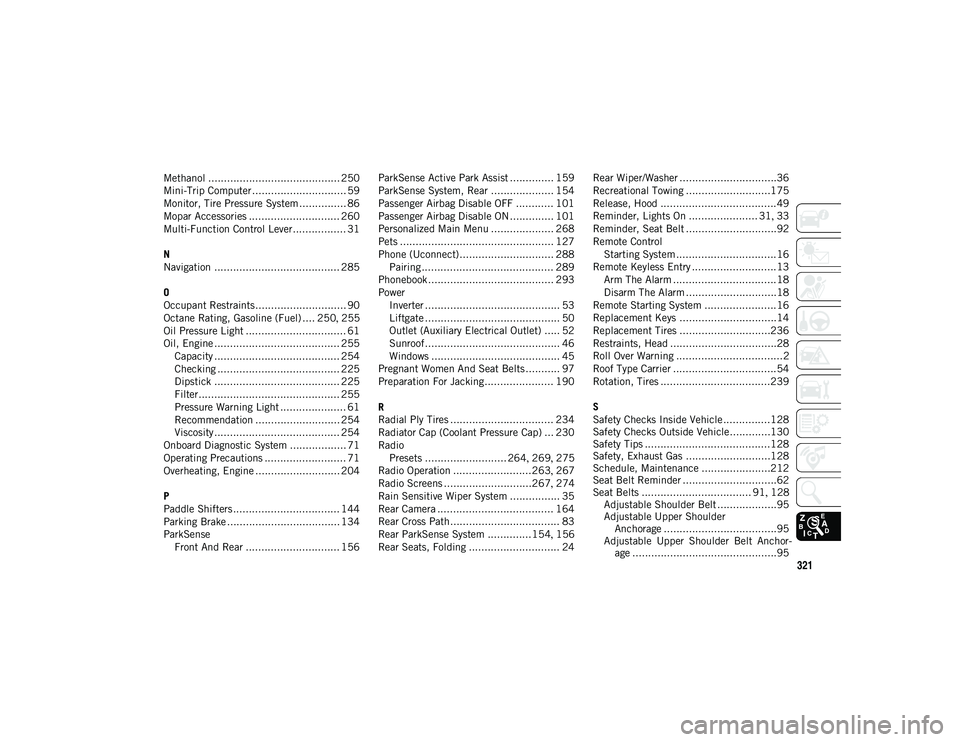
321
Methanol .......................................... 250
Mini-Trip Computer .............................. 59
Monitor, Tire Pressure System ............... 86
Mopar Accessories ............................. 260
Multi-Function Control Lever................. 31
N
Navigation ........................................ 285
O
Occupant Restraints............................. 90
Octane Rating, Gasoline (Fuel) .... 250, 255
Oil Pressure Light ................................ 61
Oil, Engine ........................................ 255 Capacity ........................................ 254
Checking ....................................... 225
Dipstick ........................................ 225
Filter............................................. 255
Pressure Warning Light ..................... 61
Recommendation ........................... 254Viscosity ........................................ 254
Onboard Diagnostic System .................. 71
Operating Precautions .......................... 71
Overheating, Engine ........................... 204
P
Paddle Shifters .................................. 144
Parking Brake .................................... 134
ParkSense Front And Rear .............................. 156 ParkSense Active Park Assist .............. 159
ParkSense System, Rear .................... 154
Passenger Airbag Disable OFF ............ 101
Passenger Airbag Disable ON.............. 101
Personalized Main Menu .................... 268
Pets ................................................. 127
Phone (Uconnect).............................. 288
Pairing .......................................... 289
Phonebook ........................................ 293
Power Inverter ........................................... 53
Liftgate ........................................... 50
Outlet (Auxiliary Electrical Outlet) ..... 52
Sunroof........................................... 46
Windows ......................................... 45
Pregnant Women And Seat Belts........... 97
Preparation For Jacking...................... 190
R
Radial Ply Tires ................................. 234
Radiator Cap (Coolant Pressure Cap) ... 230
Radio Presets .......................... 264 , 269 , 275
Radio Operation .........................263 , 267
Radio Screens ............................267 , 274
Rain Sensitive Wiper System ................ 35
Rear Camera ..................................... 164
Rear Cross Path................................... 83
Rear ParkSense System ..............154 , 156
Rear Seats, Folding ............................. 24 Rear Wiper/Washer ...............................36
Recreational Towing ...........................175
Release, Hood .....................................49
Reminder, Lights On ...................... 31
, 33
Reminder, Seat Belt .............................92
Remote Control Starting System ................................16
Remote Keyless Entry ...........................13 Arm The Alarm .................................18
Disarm The Alarm .............................18
Remote Starting System .......................16
Replacement Keys ...............................14
Replacement Tires .............................236
Restraints, Head ..................................28
Roll Over Warning ..................................2
Roof Type Carrier .................................54
Rotation, Tires ...................................239
S
Safety Checks Inside Vehicle ...............128
Safety Checks Outside Vehicle.............130
Safety Tips ........................................128
Safety, Exhaust Gas ...........................128
Schedule, Maintenance ......................212
Seat Belt Reminder ..............................62
Seat Belts ................................... 91 , 128
Adjustable Shoulder Belt ...................95
Adjustable Upper Shoulder Anchorage ....................................95
Adjustable Upper Shoulder Belt Anchor -
age ..............................................95
2020_JEEP_M6_UG_UK.book Page 321